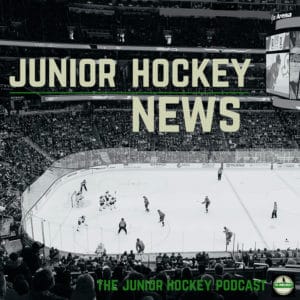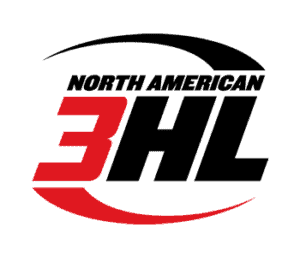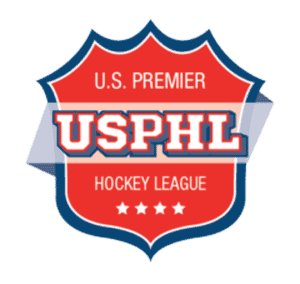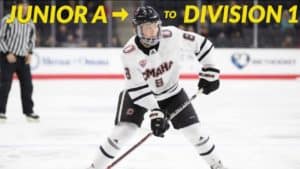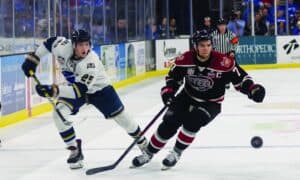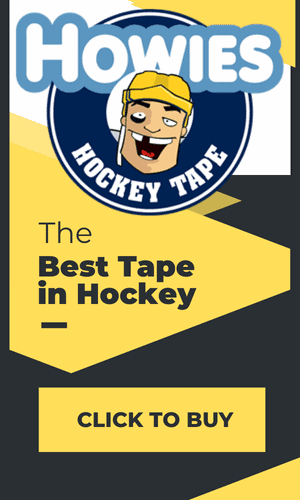
Although a bit tired and repetitive, to kick off editorial coverage we’d like to give our comprehensive overview of Junior and college-bound hockey in the United States. For those of us involved in the sport it doesn’t seem all that complicated, but for those who are interested and/or just moving into the 15-20-year-old age range, the sport can go from tidy options of Tier I and Tier II 14U hockey to an explosion of leagues and paths, all claiming to be able to get you to the same endpoint.
It is understood that Junior hockey in the United States is a small part of the overall hockey landscape in terms of participation numbers. However, since it’s the dominant jumping-off point to college hockey and the NHL draft each year, it draws an enormous amount of public attention compared to its much larger youth hockey counterpart.
Regardless of the issues within Junior hockey, the pyramid of development has worked fairly well since the mid-1990s when Junior hockey became the primary source of incoming NCAA freshmen. The pyramid has been a little oblong and a little bloated — without straight lines on all sides — but it is annually responsible for more than 90 percent of the incoming NCAA freshmen and the vast majority of the U.S.-born NHL draft picks.
Jr. Hockey In The United States Currently
Like it or not, if you’re going to play college hockey you’re probably going to play Junior hockey first, so you may as well get educated on the system and advocate for yourself. This is the only time I will cover the age-old “how to” story on Junior hockey, but it’s relevant because each year a new crop of players enters the “how-to” or the Red Zone of college-bound programs. Here is a four-paragraph summary, which is as short as it can be made, of Junior hockey in the United States:
Tier I and Tier II hockey in the United States is free-to-play. Tier I, II, and III are designations assigned by USA Hockey, which is the National Governing Organization (NGO) for amateur ice hockey in the United States. USA Hockey’s Junior terminology has become industry standard even for the couple of Junior leagues that operate outside of its purview. There is no Junior A hockey in the United States no matter what a team tells you – there is Tier I, Tier II, and Tier III.
USHL
The United States Hockey League is the only Tier I league so designated by USA Hockey, and the North American Hockey League (NAHL) is the only Tier II league so designated by USA Hockey. There are programming and player environment criteria that differentiate Tier I from Tier II. They can be found in the USA Hockey Annual Guide if you care to do a deep dive. The Eastern Hockey League (EHL) and the North American 3 Hockey League (NA3HL) are the only Tier III leagues so designated by USA Hockey. Tier III leagues are pay-to-play, which is where the term “tuition” enters the fray. Just like youth hockey, Tier III players pay a fee to teams in order to participate while Tier I and Tier II players do not pay tuition.
USPHL
The United States Premier Hockey League (USPHL) offers the National Collegiate Development Conference, which is billed as tuition-free but requires a $400 player registration fee at the league level. All in all, that’s peanuts compared to nationwide Tier III price tags, but it’s a compulsory fee so it’s not 100 percent free-to-play. The USPHL also offers the pay-to-play Premier and Elite divisions which also bill themselves as Junior or 20U hockey. All USPHL Junior divisions operate independently, meaning they are self-governed and self-insured. The USPHL is not part of the Amateur Athletic Union or any other governing entity.
WSHL
The Western States Hockey League (WSHL) is a part of AAU, meaning it is ultimately governed and insured by that entity. The AAU for many years was the NGO for numerous sports until the U.S. Olympic Committee was formed in 1978. As the name suggests, the WSHL operates mostly in the western portion of the United States and players pay tuition to participate.
What Does It All Mean?
What does it all mean and what path is the best for a player to follow? The answers are as varied as the options, and it can be different for every player, but knowing the facts about teams and leagues is a mandatory first step in the process.
A solid second step is having a college plan outside of ice hockey. After all, 99 percent of hockey players end up in the beer leagues by age 25. Knowing that’s the likely result, spending time, money, and energy getting into college and playing in college is best served by having a career plan in case the multi-million-dollar NHL contract doesn’t pan out. I speak from experience as a former player who never got The Phone Call or any phone calls for that matter, and as a parent with kids in college with the ultimate goal of getting them employed, off my payroll, and enjoying life. Intertwining hockey with a college and career plan will make the whole process better as you can keep your eye on the end goal.
A third step is being realistic about your abilities and upside. This realistic assessment can be coupled with the college/career plan to get you moving in a particular direction while minimizing the wasting of time and money trying to fit yourself into a level of play above your capabilities. If you play Tier I 16U hockey, and you excel, you’ll hear from Tier II and Tier I Junior coaches. You will get drafted or tendered – neither of which are guarantees you’ll play at that level – but it certainly can be a guideline to your self-assessment.
At Tier, I and II Junior level the coaches, organizations, and the hockey itself drives the bus, not so much the player. These organizations scout and network and will draft and tender players as they see fit according to abilities. If you are not in this pool of players you will have to be much more of a self-marketer.
Age 17 is when you really have to start making decisions about where to apply your plan and it’s also where self-advocacy becomes key.
The knock-on Tier III hockey is that it’s watered down because there are way too many organizations. While this is an opinion we share at TJHP, we also realize there is no way it will ever be controlled. Leagues are independent entities that accept franchise fees for teams that enter. To think a group of owners would buy out current members, or kick out members who have paid to get into the league, in an effort to reduce their overall business, wouldn’t fall under the Best Business Practices as taught in business school. Certainly, there is a balance between having as many members as possible while maintaining a solid product top-to-bottom. Some leagues are better than others at that balance as evidenced by the number of teams that disappear and enter a league from year-to-year.
While the current Tier III situation is much maligned, believe it or not, there were more Junior teams in the United States 18 years ago than there are now. The movement towards Junior hockey in the late 1990s and early decimated 17U hockey in many parts of the country. For example, the Washington, D.C., area had seven Junior teams at one point. That is not a traditional hockey market and 99 percent of the Junior players on those seven teams were from that area. Hockey at the 17U level all but disappeared from the area. There are currently three Junior teams in DC, and from 2011-18 there were only two, and 16U and 18U hockey is strong again. While other areas of the countries have added Junior teams, it’s good to remember that Junior hockey at the pay-to-play level was actually more watered down a couple of decades ago.
In 2004 USA Hockey re-structured
Its upper levels by creating a 16U division and increasing 17U to 18U. This allowed post-graduate players to continue playing Tier I or Tier II youth hockey if they chose. It also added yet another option to players who are trying to implement their college/career plan. It took a few years for the 16U and 18U levels to work themselves out, but about 10 years ago each level started to surge back into prominence and today the battle for the 18yo player is an all-out war with Junior and 18U programs working for the same pool of players.
As a side note, the 16U and 18U emergence has also led to “academy” hockey, which I believe is becoming the future of college-bound hockey. Academy hockey is similar to Juniors except it involves 16U and 18U teams that are recruited nationwide, with billeted players or supervised living facilities if applicable, and online high school learning environments. This allows the teams to concentrate on training both on and off the ice during the day, when ice is cheap while spending the afternoons and evenings on school and study. They can travel more because they are already in a virtual learning environment so no worries about school absences. It’s like prep school hockey except it’s all geared toward hockey and academics at roughly half the price. I realize prep schools aren’t necessarily in the hockey business, rather they are academic institutions, but we all know players attend prep schools solely because of hockey.
That brings us full circle to implementing the college/career plan
It’s clear that you will be best served by not allowing yourself to be bounced a system that encompasses recruiting 17- and 18-year-old players. You’re likely going to play Juniors until you age out and enter college as a 20- or 21-year-old freshman. It’s just the reality of NCAA hockey right now. If you pursue top-level American Collegiate Hockey Association (ACHA) you’re not going to be immune from having to play Junior hockey. Most of the top ACHA teams are full of aged-out Junior players and the level of play is not different than NCAA Division III.
Ironically the conclusion to this 2500-word editorial is: Find a team that has a coach with a history of moving players to the next level. It can be that simple. Don’t complicate it by trying to ask the coach where you’ll fit in his line-up and whether or not you’ll be on the power play. Go earn that. Do your research on the coach and the organization to see where its alumni have gone. Verify NCAA roster claims by the organization by perusing Elite Prospects or HockeyDB, or go to the school websites to check past rosters. If your end goal involves playing college hockey, find someone who excels at advancing players to college hockey. Winning games and possibly playing in front of large home crowds is nice, but if you’re not meeting your end goal it’s not going to be the best way to spend your resources. Don’t discount rookie coaches, but make sure they have learned underneath a veteran and are part of an organization with a good history. A league won’t advance you, that is all on the team and the coach.
Editor’s Introductory Note
For more than a few years I’ve had the thought of combining my writing and reporting background with ownership and management experience in college-bound hockey programs (15U, 16U, 18U, and Juniors).
I reserved a domain and set up a website seven years ago, and continued to tinker with the idea, but never did anything about it until I started discussing the coverage of college-bound hockey with The Junior Hockey Podcast crew. Blending the Podcast, editorial content, and all future social media platforms seemed the best path to capitalize on the content-hungry hockey crowd, which I believe is severely underserved. Where there are interest and passion there is an opportunity.
The Junior Hockey Podcast editorial department will specialize in speaking directly to those involved in college-bound hockey, on the record, and allow all parties to comment when a situation warrants. This site will not be driven by anonymous sources and rumors as the basis for coverage. We’re going to present facts and provide a format for participants to share their thoughts. There will be opinion pieces and editorials, but they will be clearly labeled as such.
Not using rumors and anonymous sources will be a challenge as many in the hockey world are reticent about being quoted. For too many years of people have been blasted on the internet – players, coaches, owners, and staff alike — without researched facts and without a chance to speak their peace.
In the event an anonymous source is to be cited by The Junior Hockey Podcast, it will be after the information has been verified with two other credible sources in order to verify its accuracy. This will be a two-way street for all involved in this great sport.
While we may also have a place for RSS feeds from leagues and organizations, they will not be prominently featured or disguised as original content from TJHP. Leagues don’t put out news, they put out public relations materials. I’ve run two Junior hockey leagues – we didn’t put out the information we didn’t want the public to know about. We put out PR materials and information. Watergate didn’t happen because the Republican National Committee outed itself. While that’s an extreme example, the underlying point is we’ll be an independent, non-biased site and our credibility will be evident as we progress through this venture.
Lastly, TJHP is not set up as a non-profit. This is the United States, after all, and this business that will attempt to make money. The business side of this entity and the editorial side of this entity will not be intertwined. There will be no bias brought forth because of advertising or lack of advertising. There will be promotional opportunities for leagues and teams, but just like our opinion content, they will be clearly labeled as such. As a reader and follower of TJHP you’ll never have to guess what kind of content at which you are looking or to which you are listening.
Enjoy!
Jeff Nygaard, Editor
The Junior Hockey Podcast


